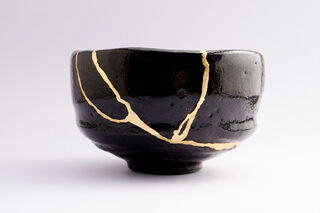
PBBT and the Art of Kintsugi
Blog post written by Camilla Grønlund, MSc, DclinPsy, Acthouse, Aarhus, Denmark. Picture Source: Marco Montalti, iStock
What would you do with a Broken cup?
Often, at least in our culture, you’d either discard it, mend it by covering the cracks, or you might put it in the back of the cupboard and buy a new, shinier cup. The implicit implication of doing this is that the damage and so-called flaws need to be hidden, handled, or turned into something different, something better.
There is an old Japanese (and Chinese) pottery art of repairing broken ceramics called Kintsugi (meaning golden joinery). The broken pieces are carefully picked up, assembled, and then glued together with gold infused lacquer. Kintsugi is not about mending, handling, or hiding the damage, but instead focuses on the damage and the story of the cup. Inside Kintsugi, there is a philosophy about embracing the damage as part of the history of the object and then quite literally turning the broken object into something that’s perhaps even more beautiful which includes the cracks and scars. It is about respecting the scars and making art out of it. It’s about letting the inherent worth of the object stand out, giving golden significance and value to what is scarred.
Why all this Focus on Cups and Ceramics?
On a professional (and personal) level, becoming acquainted with Process Based Behavior Therapy (PBBT) has been like discovering the art of Kintsugi. For me, walking my way through life and attempting to handle the stories I have about myself by trying to turn them into better, shinier ones, I now realize that I approached my “shortcomings” a bit like being on a quest for a better, improved self, where I didn’t want to show the “cracks” and “broken” parts. A tiredness started to sneak in, an overwhelm, a luring sense that I still wasn’t there yet and had far to go. Me, myself and I were often in a battle of being too much of this and too little of that. A never-ending quest for arrival.
Of course, that would sneak in on a professional level as well. Throughout my career, I have diligently worked towards becoming the ‘best’ psychologist possible. Continuously bettering myself, learning new interventions and models and constantly evaluating myself along the way. What is wrong with that – one could argue? Well, in the end, you risk losing sight of who you really are, not realizing that the person you have become is not really you, but kind of like a substitute cup. It ends up becoming a life of pretending, where the pretender doesn’t even know they pretend, stuck in this constant made-up process. At least it has been like that for me.
PBBT is teaching me to see the history of the cups as something my clients and I were taught. With gentle, patient precision, and sometimes brutal (but always kind) honesty, I’m learning to let go of the quest for the perfect cup. Instead, I’ve started to look at how the cracked parts are related – highlighting them and finding the way back to the person holding the cup. There is freedom inside of this. A freedom, not free of pain, history, or the world around us, but a freedom to radically be yourself whatever that entails.
In the words attributed to Alan Watts: “You’re under no obligation to be the same person you were five minutes ago”.




